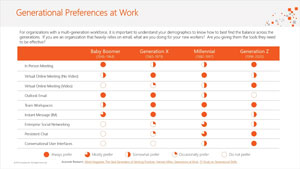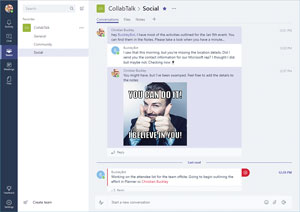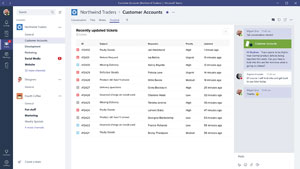In-Depth
Deep Dive into Microsoft Teams
The newest member of the "universal toolkit" aims to help Office 365 span the generational divide from millennials to baby boomers.
- By Christian Buckley
- 02/01/2017
The ways organizations collaborate and communicate vary more than ever these days, especially given the generational divide in the workplace that has many employees working with a mix of device types and preferring different modes of interaction. Likewise, the needs of those working on projects and ad hoc teams are now very different than the capabilities provided through traditional enterprise-wide collaboration platforms. Increasingly, however, businesses are looking for the tools used by project teams and their enterprise collaboration solutions to work together.
Trying to solve every collaboration and communications need to ensure engagement and productivity with a single tool is not the right approach. At the other end of the spectrum, having too many tools and too many options can also impact adoption, productivity and business efficiencies. Organizations need to find a balance -- and use the right tool for the job. Microsoft Teams, which will appear this quarter in every Office 365 and Enterprise subscription, is an ambitious bet that Microsoft can bridge existing ways of collaborating with more modern modes, notably chat.
Built from the ground up for "high-velocity" teams and leveraging all that Office 365 offers, Microsoft Teams is the company's response to demand for chat-based interaction made popular by tools such as Slack. Since releasing the Microsoft Teams preview in early November at a launch event in New York, Microsoft critics and supporters alike have heaped praise on it. But the impact to Microsoft's broader Office 365 messaging -- and the blurring of lines between collaboration and communication tools -- remains a question.
Microsoft Teams Inspiration
At the core of Microsoft CEO Satya Nadella's message at the recent launch event was the continuation of the themes that he introduced in his first keynote after taking the helm as CEO, delivered to the 2014 Worldwide Partner Conference, where he talked extensively about transforming collaboration and reinventing productivity.
"When it comes to digital work and life experiences, the thing that we're going to do is start by building great experiences individually," he said at the time. "That means we're going to have fantastic e-mail, great file
sharing, great communication and collaboration. There's Skype, there's Outlook, there's OneDrive. But it's just not about any one of these applications. It's not the application silos themselves. We are building an operating system for human activity across all of their daily lives, across all of their devices. That is what the future of Office, the future of Dynamics represents for us."
Where most keynotes tend to be more about future vision and aspirational messages, customers were both eager and alarmed by Nadella's promise. In speaking about the increasing complexity of solutions that are available to information workers, and the need to use the right tool for the right problem, he positioned Office 365 as the "universal toolkit" for organizations. The new Microsoft Teams looks like a strong new addition to the Office 365 toolkit. But there's much work to be done to help customers understand which tool to use, and when to activate Microsoft Teams when it appears in Office 365 in the coming months.
Avanade, one of Microsoft's largest consulting partners, was an early tester of Microsoft Teams prior to the company's announcement. The firm fielded a survey to determine how employees from different age groups ranging from baby boomers to millennials prefer to collaborate and communicate (see Figure 1). Wictor Wilen, a digital workplace architect at Avanade, said in a blog post that no one tool is sufficient to meet the generational preferences of employees as workplaces become not only more diverse, but people rely on different devices.
 [Click on image for larger view.]
Figure 1. A study by Microsoft partner Avanade outlines how workers in various age groups prefer to use different modes of collaboration and communications.
[Click on image for larger view.]
Figure 1. A study by Microsoft partner Avanade outlines how workers in various age groups prefer to use different modes of collaboration and communications.
Microsoft Teams is poised to fill an important gap among enterprise workgroups, according to Wilen, who is also a Microsoft Certified Architect (MCA) and a SharePoint MVP. "Covering an area that has been somewhat missing between instant messaging (Skype for Business), e-mail (Outlook/Exchange), and enterprise social networks (Yammer), and at the same time having enough overlap on these services to accommodate for personal, cultural, generational, and workstyle preferences [is important]," Wilen noted.
Information Integrated and More Visible
The core of Microsoft Teams is a new chat-based workspace, built "from the ground up" on Office 365, Kirk Koenigsbauer, corporate vice president for the Office team, explained in his Nov. 2 blog post announcing the preview. Emphasizing the point that Office 365 runs on Microsoft's global and secure cloud, Koenigsbauer also recognized that the ways in which teams collaborate and communicate have gone through tremendous changes. In addition to a more diverse workforce, the modern enterprise is much more agile (or attempts to be) and organizational structures are more flat than the traditional hierarchies, making communication and the rapid flow of information more important than ever before. "With Microsoft Teams, we aspire to create a more open, digital environment that makes work visible, integrated and accessible -- across the team -- so everyone can stay in the know," he said.

"With Microsoft Teams, we aspire to create a more open, digital environment that makes work visible, integrated and accessible – across the team -- so everyone can stay in the know,"
Kirk Koenigsbauer, Office Team Corporate VP, Microsoft
Microsoft Teams delivers on the three G's at the core of everything being delivered through Office 365: Groups, Graph and Governance. While the preview of Microsoft Teams is accessed through Teams.Microsoft.com today, when generally available Microsoft Teams will become part of Office 365 Groups, with all conversations and data accessible through the Microsoft Graph, and the service managed by the Office 365 centralized governance and management console. This is where Microsoft Teams immediately takes a commanding lead over competitors like Slack -- because Teams is part of a broader platform, not another standalone solution.
Microsoft Teams consists of four core components:
- Chat: Microsoft Teams provides a modern conversation experience, providing threaded conversations that are persistent (see Figure 2). In other words, the conversations you have within Microsoft Teams become information assets that are saved and become searchable via Microsoft Graph. By default, these conversations are visible to everyone on the team, though you can launch a private discussion. Out of the box there's deep Skype integration, giving users voice and video capabilities, as well as a full range of modern visual communication tools to help increase engagement, such as emojis, stickers, GIFs and custom memes.
 [Click on image for larger view.]
Figure 2. The Microsoft Teams lets users create threaded chats for each of their groups.
[Click on image for larger view.]
Figure 2. The Microsoft Teams lets users create threaded chats for each of their groups.
- Hub for teamwork: As a full-fledged member of an Office 365 Group, Microsoft Teams leverages the full breadth and depth of Office 365, including Word, Excel, PowerPoint, SharePoint, OneNote, Planner, Power BI and Delve. Because Microsoft Teams was built leveraging the full capability of Microsoft Graph, teams or workgroups have the ability to share data, intelligence and insights anywhere within Office 365 (most likely with limitations at first but eventually as the service is expanded). Intelligent services, such as connecting to SAP, or tickets within your Jira platform, can be surfaced through the workspace to help with information relevancy, discovery and sharing. Because Microsoft Teams is part of Office 365 Groups, it will preserve context (of course, that depends on how you define "context," which I'll address later).
- Customizable: This is an important requirement of any tool in this day and age. All organizations are unique, and adoption and engagement increase when the tools we use can be tailored to meet unique cultural and business needs. Microsoft Teams will offer rich extensibility and open APIs at general availability, and will leverage the same Connector model as Exchange, providing notifications and updates from third-party services like Twitter and GitHub. It will also have full support for the Microsoft Bot Framework, allowing organizations to create and customize the tools and intelligent services they bring into Microsoft Teams (see Figure 3).
 [Click on image for larger view.]
Figure 3. This customization of Microsoft Teams has a ZenDesk tab. ZenDesk is one of 150 partners planning integration.
[Click on image for larger view.]
Figure 3. This customization of Microsoft Teams has a ZenDesk tab. ZenDesk is one of 150 partners planning integration.
- Security: This is a key differentiator for Microsoft Teams. Providing advanced security and compliance capabilities through the Office 365 platform means data is encrypted in transit and at rest, and the solution meets compliance standards, including the EU Model Clauses, ISO 27001, SOC 2 and HIPAA. As part of Office 365, Microsoft Teams is supported through Microsoft's global network of datacenters, which the company maintains has a transparent operational model with no standing access to customer data. All teams are automatically provisioned within Office 365, and managed centrally through the Admin console.
Extending Microsoft Teams with Chat Bots
At the core of Microsoft Teams is an Internet Relay Chat-style experience that provides persistent, threaded discussions. In other words, you can jump into a conversation as it happens, but also come back later and search through the conversation as if you were digging through any other information asset. Each team has one or more "channels" which can be set up for specific projects, topics, or business teams, within which you can chat, share files, and interact with external services via Office 365 Connectors, much like Slack does.
An important aspect of Microsoft Teams is the ability to extend them through the creation of "chat bots" that leverage Bot Framework, helping customers to leverage more of their own stored knowledge using machine learning and Microsoft Graph.
The best description for Microsoft Teams is it supports "high-velocity" organizations, or those aspiring to pick up the pace. For example, a support team member might create channels for instant, yet persistent discussions around different customer problem areas, allowing her to pull the right people together quickly to discuss a real-time resolution. The output of that discussion might then be folded into a Frequently Asked Questions (FAQ) document in SharePoint or added to the relevant Yammer Group as part of the organization's growing knowledge base.